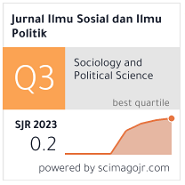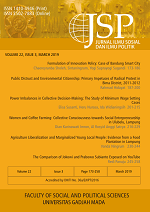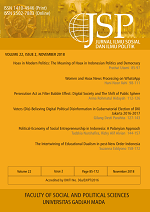Post COVID-19 Pandemic International Travel: Does Risk Perception and Stress-Level Affect Future Travel Intention?
Ahmad Febri Falahuddin(1*), Clare Teroviel Tergu(2), Rachele Brollo(3), Ratih Oktri Nanda(4)
(1) School of Tourism Management, Zhengzhou University, Zhengzhou 450000, P.R. China
(2) School of Tourism Management, Zhengzhou University, Zhengzhou 450000, P.R. China
(3) School of Tourism Management, Zhengzhou University, Zhengzhou 450000, P.R. China
(4) School of Public Health, Nanjing Medical University, Nanjing 211146, P.R. China
(*) Corresponding Author
Abstract
The COVID-19 pandemic has extremely affected several industries including international travel and tourism. Many scholars have tried to describe the cause-effects of this major phenomenon. This study majorly aims to explore the relationship between risk perception and travel intention where stress level prone to COVID-19 quarantine serves as a moderating factor. The researchers believed that the influence of the dimensions of risk perception including social risk, psychological risk, physical risk, performance risk, financial risk and time risk on travel intention will be significant when the variable of stress level intervenes. This paper used a quantitative approach involving 409 respondents around the world. The data were gathered via online questionnaires facilitated by Google form and Wenjuanxing. The respective questionnaires were available in five languages (Chinese, English, Italian, French and Indonesian). Both descriptive and inferential statistics were used to analyze the data. The outcome of the hierarchical multiple regression (HMR) test resulted in a positive connection between all independent variables and travel intention simultaneously but not partially. The uppermost influence was found in social risk. Meanwhile, financial risk and time risk indicate no significant relationship. Lastly, the researchers believe that understanding the relationships between the variables of this study would be beneficial for the DMOs to predict the future market and rearrange strategies after being affected by the pandemic.
Keywords
Full Text:
PDFReferences
Ahn, T., Ekinci, Y., & Li, G. (2013). Self-congruence, functional congruence, and destination choice. Journal of Business Research, 66(6), 719–723. https://doi.org/10.1016/j.jbusres.2011.09.009
Ajzen, I., & Fishbein, M. (1980). Understanding attitudes and predicting social behavior. Englewood Cliffs, NJ: Prentice Hall.
Artuğer, S. (2015). The Effect of Risk Perceptions on Tourists’ Revisit Intentions. European Journal of Business and Management, 7(2), 36-43.
Bhasin, H. (2018, July 17). Perceived risk. Retrieved from https://www.marketing91. com/ perceived-risk/ #Definition-of- PerceivedRisk
Chen, H.-B., Yeh, S.-S., & Huan, T.-C. (2014). Nostalgic emotion, experiential value, brand image, and consumption intentions of customers of nostalgic- themed restaurants. Journal of Business Research, 67(3), 354–360. https://doi. org/10.1016/j.jbusres.2013.01.003
Chin, L. C., & Leng, L. H., Yuan, N. S., & Xiong P. Y. (2015). Determinants of travel intention among foreign students in Malaysia-perspective from push-pull motivations [Unpublished Bachelor’s Thesis]. University of Tunku Abdul Rahman, Malaysia.
Cho, S.-H., Ali, F., & Manhas, P. S. (2018). Examining the impact of risk perceptions on intentions to travel by air: A comparison of full -service carriers and low-cost carriers. Journal of Air Transport Management, 71, 20–27. https://doi.org/ 10.1016/j. jairtraman.2018.05.005
Cohen, S., Kamarck T., & Mermelstein, A. (1983). Global Measure of Perceived Stress. Journal of Health and Social Behavior, 1983, 24(4), 385-396. doi: 10.2307/2136404
Cui, F., Liu, Y., Chang, Y., Duan, J., & Li, J. (2016). An overview of tourism risk perception. Natural Hazards, 82. https://doi.org/10.1007/ s11069-016-2208-1.
Fuchs, G., & Reichel, A. (2006). Tourist Destination Risk Perception: The Case of Israel. Journal of Hospitality and Leisure Marketing, 14 (2), 83-10. https://doi.org/10.1300/J150v14n02_06
Gössling, S., Scott, D. & Hall, M. C. (2020). Pandemics, tourism and global change: a rapid assessment of COVID-19. Journal of Sustainable Tourism, 29(1), 1-20. https://doi.org/10.1080/09669582.2020.1758708
Hasan, M. K., Ismail, A. R., & Islam, M. F. (2017). Tourist risk perceptions and revisit intention: a critical review of literature. Cogent Business & Management, 4(1). https:// doi.org/10.1080/23311975.2017.1412874
Hashim, N. A. A. N., Noor, M. A. M., Awang, Z., Aziz, R. C., & Yusoff, A. M. (2018). The Influence of Tourist Perceived Risk towards Travel Intention: A Conceptual Paper. International Journal of Academic Research in Business and Social Sciences, 8(16), 92–102. https://doi.org/10.6007/IJARBSS/v8-i16/5120
Jang, S. S., Bai, B., Hu, C., & Wu, C. M. E. (2009). Affect, travel motivation, and travel intention: A senior market. Journal of Hospitality & Tourism Research, 33(1), 51-73. https://doi.org/10.1177/1096348008329666
Kaplan, L. B., Szybillo, G. J., & Jacoby, J. (1974). Components of perceived risk in product purchase: A cross-validation. Journal of Applied Psychology, 59(3), 287–291. https://doi.org/10.1037/h0036657
Khan, M. J., Chelliah, S., Haron, M. S., & Ahmed, S. (2017). Role of Travel Motivations, Perceived Risks, and Travel Constraints on Destination Image and Visit Intention in Medical Tourism: Theoretical model. Sultan Qaboos University medical journal, 17(1), e11–e17. https://doi.org/10.18295/squmj.2016.17.01.003
Khan, M. J., Chelliah, S., Khan, F., & Amin, S. (2019). Perceived risks, travel constraints and visit intention of young women travelers: the moderating role of travel motivation. Tourism Review, 74(3), 721–738. https://doi. org/10.1108/tr-08-2018-0116
Kim, M., Choi, K. H., & Leopkey, B. (2019). The influence of tourist risk perceptions on travel intention to mega sporting event destinations with different levels of risk. Tourism Economics, 135481661987903. https://doi. org/10.1177/1354816619879031
Kozak, M., J. C. Crotts, and R. Law. (2007). The Impact of the Perception of Risk on International Travelers. International Journal of Tourism Research, 9(4), 233-242. https://doi.org/10.1002/jtr.607
Lee, C. K., Song, H. J., Bendle, L. J., Kim, M. J., & Han, H. (2012). The impact of non- pharmaceutical interventions for 2009 H1N1 influenza on travel intentions: A model of goaldirected behavior. Tourism Management, 33(1), 89–99. https://doi. org/10.1016/j.tourman.2011.02.006
Lenggogeni, S. (2015). Travel risk perceptions, travel intentions, and influencing factors: A natural disaster context [Ph.D. Thesis, UQ Business School, The University of Queensland]. UQ eSpace. https://doi. org/10.14264/uql.2015.233
Maslow, A. H. (1943). A theory of human motivation. Psychological Review, 50(4): 370–96. http://dx.doi.org/10.1037/h0054346
Mody, M., Day, J., Sydnor, S., Jaffe, W., & Lehto, X. (2014). The different shades of responsibility: Examining domestic and international travelers’ motivations for responsible tourism in India. Tourism Management Perspectives, 12, 113–124. https://doi.org/10.1016/j. tmp.2014.09.008
Mohamed, N., & Othman, N. (2012). Push and Pull Factor: Determining the Visitors Satisfactions at Urban Recreational Area. Procedia - Social and Behavioral Sciences, 49, 175–182. https://doi.org/10.1016/j. sbspro.2012.07.016
Moreira, P. (2008). Stealth risks and catastrophic risks: On risk perception and crisis recovery strategies. Journal of Travel & Tourism Marketing, 23 (2–4), 15–27. https:// doi.org/10.1300/J073v23n02_02
Naidoo, P., Ramseook-Munhurrun, P., Seebaluck, N. V., & Janvier, S. (2015). Investigating the Motivation of Baby Boomers for Adventure Tourism. Procedia-Social and Behavioral Sciences, 175, 244–251. https://doi. org/10.1016/j.sbspro.2015.01.1197
Park, S. C., & Park Y. C. (2020). Mental Health Care Measures in Response to the 2019 Novel Coronavirus Outbreak in Korea. Psychiatry Investig, 17(2), 85-86. https://doi. org/10.30773/pi.2020.0058
Pike, S., & Ryan, C. (2004). Destination Positioning Analysis through a Comparison of Cognitive, Affective, and Conative Perceptions. Journal of Travel Research, 42(4), 333–342. https://doi. org/10.1177/0047287504263029
Qi, C. X., Gibson, H. J., & Zhang, J. J. (2009). Perceptions of Risk and Travel Intentions: The Case of China and the Beijing Olympic Games. Journal of Sport & Tourism, 14(1), 43–67. https://doi. org/10.1080/14775080902847439
Reisinger, Y., & Mavondo, F. (2005). TravelAnxiety and Intentions to Travel Internationally: ImplicationsofTravelRiskPerception. Journal of Travel Research, 43(3), 212–225. https://doi. org/10.1177/0047287504272017
Riley, C. (2020, April 15). ‘This is a crisis.’ Airlines face $113 billion hit from the coronavirus. Retrieved from https://edition. cnn.com/2020/03/05/business/airlines- coronavirus-iata-travel/index.html
Sancho, E. F., & Álvarez, R. J. (2010). Tourism Destination Image and Motivations: The Spanish Perspective of Mexico. Journal of Travel & Tourism Marketing, 27(4), 349–360. https://doi.org/10.1080/10548408.2010.481567
Sjöberg, L., Moen, B. E., & Rundmo, T. (2004). Explaining risk perception. An evaluation of the psychometric paradigm in risk perception research. Rotunde, 84, 1–33.
Sridhar, S., Régner, I., Brouqui, P., & Gautret, P. (2016). Methodologies for measuring travelers’ risk perception of infectious diseases: A systematic review. Travel Medicine and Infectious Disease, 14(4), 360–372. https://doi.org/10. 1016/j.tmaid.2016.05.012
Um, S., Chon, K., & Ro, Y. (2006). Antecedents of revisit intention. Annals of Tourism Research, 33(4), 1141–1158. https://doi.org/10.1016/j. annals.2006.06.003
Wang, C., Pan, R., Wan, X., Tan, Y., Xu, L., Ho, C.S., & Ho, R.C. (2020) Immediate Psychological Responses and Associated Factors during the Initial Stage of the 2019 Coronavirus Disease (COVID-19) Epidemic among the General Population in China. International Journal of Environment Research & Public Health, 17(5). https://doi. org/10.3390/ijerph17051729
Wu, C. W. (2015). Foreign tourists’ intentions in visiting leisure farms. Journal of Business Research, 68(4), 757-762. h ttps : //d o i . org/10.1016/j.jbusres.2014.11.024
Wulandari, S., Amani, H., & Athari, N. (2018). The Determinants of Accident Risk Perception, Travel Motivation, eWOM and Travel Intention on Island Tourism Destination. Atlantis Highlights in Engineering (AHE), 2, 348-352. https://doi.org/10.299 1/icoiese-18.2019.61
Yang, Y., Zhang, H., & Chen, X. (2020). Coronavirus pandemic and tourism: Dynamic stochastic general equilibrium modeling of infectious disease outbreak. Annals of Tourism Research, 83(2020), 102913. https://doi.org/10.1016/j.annals. 2020.102913
Yazid, A. S., Yusof, M. Y. M., Rashid, N., Ghazali, P. L., Salleh, F., Mahmod, M. S., & Mahmood, S. (2018). A Mediating Effect of Risk Perception on Factors Influencing Tourist Intention to Travel: A Conceptual Framework. International Journal of Academic Research in Business and Social Sciences, 8(11), 1246–1255. https://doi.org/10.6007/ IJARBSS/v8-i11/5166
Zelenka, J., & Pásková, M. (2012). Tourism–explanatory dictionary. Praha: Linde.
Article Metrics
Refbacks
Copyright (c) 2021 Jurnal Ilmu Sosial dan Ilmu Politik

This work is licensed under a Creative Commons Attribution-NonCommercial-NoDerivatives 4.0 International License.






















